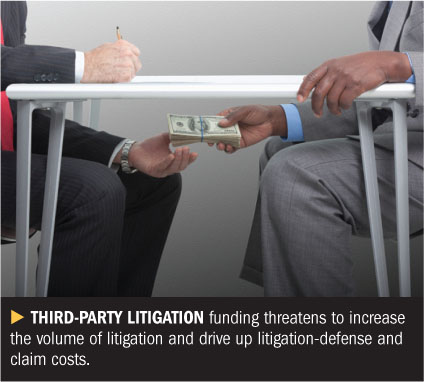Since medieval times, jurists have condemned "champerty," the practice of giving money to potential litigants to file and maintain lawsuits in return for a share of the proceeds. But in recent years, opposition to champerty has weakened, opening the door to third-party litigation funding, a burgeoning industry that threatens to increase the volume of litigation and drive up litigation-defense and claim costs. P&C insurers should take careful note of this development.
 Third-party litigation funding takes several forms. In the most common example, a funding company provides thousands of dollars to a personal-injury plaintiff and charges interest at annualized rates that can exceed 100 percent of the loan value. These "loans" are generally not subject to state usury laws because they are made on a non-recourse basis: If the plaintiff loses, the funder has no claim for repayment.
Third-party litigation funding takes several forms. In the most common example, a funding company provides thousands of dollars to a personal-injury plaintiff and charges interest at annualized rates that can exceed 100 percent of the loan value. These "loans" are generally not subject to state usury laws because they are made on a non-recourse basis: If the plaintiff loses, the funder has no claim for repayment.
Alternatively, the funding company is a specialized investment firm or hedge fund and the borrower a corporate litigant or law firm. Instead of charging interest, the funder receives a predetermined share of any proceeds that result from the lawsuit. In these cases, the funds advanced—which may exceed $15 million—are referred to as "investments" instead of "loans." But regardless of what they are called, third-party funding arrangements turn lawsuits into assets that are partly owned by profit-seeking financiers.
Recommended For You
Want to continue reading?
Become a Free PropertyCasualty360 Digital Reader
Your access to unlimited PropertyCasualty360 content isn’t changing.
Once you are an ALM digital member, you’ll receive:
- Breaking insurance news and analysis, on-site and via our newsletters and custom alerts
- Weekly Insurance Speak podcast featuring exclusive interviews with industry leaders
- Educational webcasts, white papers, and ebooks from industry thought leaders
- Critical converage of the employee benefits and financial advisory markets on our other ALM sites, BenefitsPRO and ThinkAdvisor
Already have an account? Sign In Now
© 2025 ALM Global, LLC, All Rights Reserved. Request academic re-use from www.copyright.com. All other uses, submit a request to [email protected]. For more information visit Asset & Logo Licensing.








